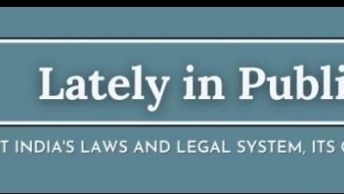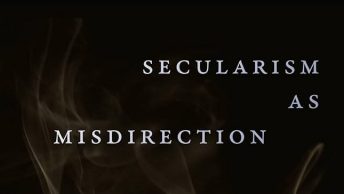The judgment of the Supreme Court in the case of Swamy Shraddananda on 22nd July deserves much more attention than it has received. It is a strong statement against the death penalty. Although it does list a few reasons why the instant case was not considered ‘rarest of the rare’, it is clear that the reluctance to award the death penalty was due to much larger concerns: poor criminal justice administration and in particular the failure of the Supreme Court to be consistent in sentencing in capital cases. The judgment also provides a useful analysis of the landmark Bachan Singh and Machhi Singh judgments. (The judgment and an earlier post on this blog can be read here).
Besides the above, however, the judgment also sentences the accused to life imprisonment with a direction: “he shall not be released from prison till the rest of his life”. Although this is not the first instance where the Supreme Court has sentenced a person to life imprisonment without possibility of release, this is the first instance where the apex court claims to provide “good and sound legal basis” for this new form of punishment. Previous judgments awarding similar punishments had not even bothered to do so. One of my earlier articles on the subject can be read here.
Yet many questions remain with respect to the “good and sound legal basis” provided in terms of life imprisonment.
There is little doubt that when awarded by the court, life imprisonment means incarceration for the rest of the convict’s natural life. However there is equally no doubt that after the pronouncement of the sentence it is the executive which has the power and duty to make the decision on releasing the convict and furthering his reintegration into society. This is expressly laid down in the CrPC (Sections 432 – 435). In the first few decades after independence, it was widely believed that ‘lifers’ spent too little in time in prison as the authorities released them even after only 6 or 7 years. This was also noted by the Supreme Court in a number of cases. A direct result was the insertion of Section 433A in the CrPC in 1978 by which the legislature restrained the executive from exercising the power of release before 14 years of actual imprisonment were served. This was specifically for cases where life imprisonment was an alternative sentence to the death penalty or where the death sentence was commuted by the executive to life imprisonment.
It is generally believed that most persons sentenced to life are released after the 14 years are completed to the extent that that is common to correlate life imprisonment with a 14 year term. The present judgment also believes the same relying on information from two states and assuming that it would be the same in the remaining twenty odd. Perhaps the Court could have sought statistics from the Governments showing what percentage of lifers are released after the minimum incarceration of 14 years and how many lifers serve more than the minimum sentence. Such data is not available from the National Crime Records Bureau’s publications and would be essential to know before arriving at conclusions on the efficacy of the current terms of life imprisonment.
The present judgment goes into great detail into how lifers are released after earning remissions for good behaviour etc (provided in the various Prison Acts). They question how this is allowed given that remissions are as deduction of days from a sentence and no such deduction is possible from a life sentence which is by its very nature indeterminate. They find no merit in the process followed by Prisons whereby a life sentence is deemed to be 20 years for calculation of remissions. The judgment is correct in this respect and in fact this has also been previously noted in many judgments (also referred by the Hon’ble judges) which have expressly laid down that a lifer cannot claim release from his life imprisonment despite earning remissions unless the executive remits the whole remaining sentence.
The Hon’ble judges however take a huge jump when they move from the above valid conclusion to the assertion that the executive therefore cannot prematurely release a lifer. This conclusion is not supported by the judgments cited and certainly not by the provisions of the CrPC. While convicts cannot be released solely on the basis of their earned ‘ordinary’ remissions, section 432 specifically refers to the executive power of ‘whole’ remissions and commutations. This means at any time after the minimum sentence period of 14 years, the executive has the power to remit the whole of the remaining sentence of the accused. This provision has not even been discussed in the instant judgment which only discusses the ordinary remissions permitted by the Prison/Jail manuals and awarded by the Prisons Department.
This omission is quite surprising since the bench itself refers extensively to the process that takes place in Bihar and Karnataka when a lifer it to be released. This process involves reports on the prisoner prepared by the Prisons Department. These are then put forward before a State Remissions Board which examines the case and the State Government takes a decision after considering the recommendation of the Board. Without actually referring to any illustrations, cases or data that show the failure of this system, the Supreme Court takes ‘judicial notice’ that “remission is allowed to life convicts in the most mechanical manner without any sociological or psychiatric appraisal of the convict and without any proper assessment as to the effect of the early release of a particular convict on the society.” Even if the court is correct in its assessment – a matter as serious as this deserves more data and study than mere resort to ‘judicial notice’.
This sole ‘fact’ is then the basis for the Court to conclude: “the unsound way in which remission is actually allowed in cases of life imprisonment make out a very strong case to make a special category for the very few cases where the death penalty might be substituted by the punishment of imprisonment for life or imprisonment for a term in excess of fourteen years and to put that category beyond the application of remission.”
Besides the obvious penology issues involved, such a step has no procedural basis. It is not clear how the Court can take away statutory remission powers of the executive without first striking down Section 432 of the CrPC. In the absence of such a step, the Court’s direction restricting the executive from exercising its powers of remission would severely impinge on executive powers and be arguably unconstitutional as it may be violative of the basic feature requirement of ‘separation of powers’.
That the Hon’ble judges take such an extreme step without rebutting the valid contentions of the defence and knowing well that a writ petition on the same legal point is pending before another bench of the Supreme Court is extremely surprising. No doubt the Court was concerned that the accused had already spent 14 years in custody and could be released shortly. However this could have been avoided by a strongly-worded suggestion to the executive to not release the particular convict. The attempt to legislate a new punishment solely under the control of the judiciary is a clear illustration of judicial over-reach. The argument that this brazen foray into executive power was for a ‘good’ cause (keeping society safe and severely restricting the death penalty to the ‘rarest of the rare’) cannot replace the serious constitutional and penological damage caused by this and other previous similar judgments.
(Bikram Jeet Batra is a lawyer and researcher. He can be reached at bjbatra@gmail.com)






Bikram,
Dont you think this is an instance of the judiciary issuing a direction on a possible future exercise of executive discretion (admittedly unjustified and clearly lacking constitutional propriety) rather than any attempt at interfering with any legislative function. If so, “he shall not be released from prison till the rest of his life” may merely be a directive to the executive and while it has constitutional and penological implications, it may be different rom the obvious problems with judicial attempts to legislate a new punishment. Wot do you think?
No doubt, of course, it is a case of judicial over reach (or as a judge once remarked, a lack of modesty).
regards,
Mathew
Hi Mathew,
Here’s what the judgment says in Para 38: “This Court, therefore, must lay down a good and sound legal basis for putting the punishment of imprisonment for life, awarded as substitute for death penalty, beyond any remission and to be carried out as directed by the Court so that it may be followed, in appropriate cases as a uniform policy not only by this Court but also by the High Courts, being the superior Courts in their respective States.”
I think the last bit makes quite clear that the intent is to create a new life imprisonment that the executive cannot ‘interfere’ with.
Remission of sentences should left to the executive to decide.Court can insist on rules and guidelines
that are applicable to all life term convicts so that the bias in
decision making in removed or atleast curtailed.Unfortunately by this judgment the judiciary has assumed that only it has the
final say in the matter.Remission
of sentences is also an issue of
public policy and condonation
and remissions do have a place
in criminal justice system.
Courts should step in if there
is an abuse of power to grant
remissions and pardon.Unless proved
otherwise such acts of remission
should be deemed to have done
in good faith and for valid reasons.To deny any remission by the executive in some cases is certainly an act of over reach.
Hello,
A recent judgment (early September) by Pasayat J. is relevant to this discussion.
One aspect of the judgment in Sharaddananda (both the two-Judge split and the 3-Judge decision) was the discussion on the appropriateness of the death penalty in cases where the conviction was based solely on circumstantial evidence. Justice Sinha seemed to suggest that given the nature of the death penalty, it would be wiser not to impose it where conviction was based solely on circumstantial evidence. The larger Bench – in general – agreed with this view.
Justice Pasayat – writing for a two Judge Benchin Shivaji v. State of Maharashtra Crl. Appeal 1409/2008 – refutes this logic, stating that the nature of evidence is immaterial at the time of sentencing; even when the death sentence is being contemplated.
What is interesting is that he makes no reference to Sharaddananda – either on the specific point or in connection with the general move away from the death penalty in Sharaddananda.
Is Justice Pasayat’s judgment per incuriam? Or will Sharaddananda be interpreted as conflicting with earlier larger Bench decisions?
In any event, this does serve to highlight another of the arguments against the death penalty – does too much depend on which Bench you end up before?